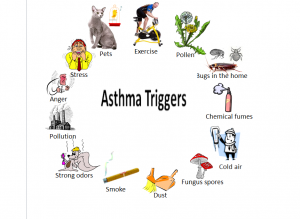Allergies affect millions of people every year, few are acute (recent origin) cases and few are chronic (long standing) cases. Some don’t even know about it and they keep on bearing these uncomfortable symptoms and consequences. Symptoms may vary from mild to life threatening.
Global scenario –
Allergic diseases occur in wide spectrum presentation ranging from life-threatening anaphylaxis to food allergies, certain forms of asthma, rhinitis, conjunctivitis, angioedema, urticaria, eczema, eosinophilic disorders, including eosinophilic esophagitis and drug and insect allergies.
Globally 300 million people are affected from asthma and about 200 to 250 million people suffer from food allergies 1. One tenth of the population is affected from drug allergies and 400 million from rhinitis 1. Moreover, allergic diseases usually occur together in the same individual, with one disease with the other. This requires a comprehensive approach towards diagnosis and treatment and greater awareness of the underlying causes amongst family physicians, patients as well as other specialists like pulmonologist, dermatologists, chest physicians etc.
The prevalence of respiratory allergies is still the highest among children (10.1%)2. In children, asthma, allergic rhinitis, and atopic dermatitis cause significant morbidity and school absenteeism. In case of adults, with adverse consequences for performance, productivity and quality of life, it creates economic burden which is measured in billions of dollars.
What is Allergy?
Allergy is caused by an inappropriate response of the immune system to a foreign substance, known as an “allergen” which is otherwise harmless. Allergen could be pollen, house dust mites, foods, etc.
What are the trigger factors or ‘Allergens’ causing Allergies?
Many allergens can trigger an allergic response. Some common allergens include:
- foods (such as berries, shellfish, fish, nuts, eggs, and milk)
- pollen
- Dust, Dust mites
- Medications
- emotional stress
- Exercise
- exposure to water, sunlight, cold or heat
- insect bites
- animal dander

What are the common Allergic Disorders?
- Hay Fever (Seasonal Allergies)
- Sinusitis
- Asthma
- Eczema
- Hives / Urticaria
- Food Allergy
- Animal Allergy
- Contact dermatitis
- Anaphylaxis
- Drug Allergy/latex allergy
- Hay Fever is also known as seasonal allergy. It was coined as seasonal allergy because symptoms were seen year after year during harvest season.
During seasonal allergy, usually the tissues lining your nose become inflamed, causing a stuffy feeling. Some other symptoms may include sneezing, runny nose, itchy throat, and red, itchy eyes.
Sinusitis is the inflammation of the mucous membranes in the sinuses. It is caused commonly by infection, allergies and irritation from toxic substances in the air. Acute sinusitis can be treated with steam inhalation, antibiotics and draining procedure. Chronic cases can be treated with FESS (Functional Endoscopic Sinus Surgery).
Asthma is a disease affecting the airways that carry air into and out of the lungs.
Symptoms differ from person to person, but may include coughing, wheezing, shortness of breath, chest tightness, or producing a lot of mucus. Few people are more prone to get an Asthma. For example, if one of parents have asthma, person will be more likely to get it. If one has allergies, you are more likely to develop asthma also. Anti-inflammatory medicines and bronchodilators are main treatment modalities for Asthma.
Eczema is thought to be a hereditary allergic disease that can cause chronic, superficial inflammation of the skin causing redness, edema, oozing, crusting, scaling and intense itching often found in the creases of joints and the trunk. Scratching may lead to bleeding and infection.
Urticaria or Hives, are raised red welts of various size on the surface of the skin. Hives are often itchy and associated with an allergic reaction and histamine release or abnormalities in parts of the immune system. Hives may be uncomfortable, but they generally are harmless and disappear on their own in milder cases, but in moderate to severe urticaria, oral antihistaminic provide relief.
Food Allergy and Food Intolerance – A food intolerance is not the same as a food allergy. These words are not interchangeable. A food allergy occurs when the body’s immune system reacts abnormally to specific foods. However, no allergic reaction takes place with a food intolerance. In food intolerance, the symptoms may be caused by difficulties digesting certain substances in food. One example is lactose, a sugar found in milk and dairy products.
Animal Allergy – An abnormal immune reaction in the proteins of animal skin, dander, saliva, blood or urine. Once the source is removed, allergy might disappear or sometimes, treatment is needed.
Contact dermatitis- It is skin rash caused by contact with certain substance.
Anaphylaxis is an acute system type but severe type of allergic reaction which could be life threatening. It occurs when a person’s immune system has been triggered to recognize a substance as a threat to the body.
How anaphylaxis occurs:
The immune system releases antibodies. The tissues release histamine and other substances. This causes muscle contractions and constriction of the airways resulting in wheezing, difficulty in breathing, and gastrointestinal symptoms—abdominal pain, vomiting, diarrhea and cramps. Histamine causes the blood vessels to dilate, which lowers the blood pressure, and fluid to leak into the air sacs of the lungs, causing pulmonary edema. Hives and angioedema often occur, and on the lips, eyelids, throat, etc.)
Although anaphylaxis occurs infrequently, it is life threatening and can occur at any time. It is medical emergency and immediate administration of injection named epinephrine or adrenaline, could be lifesaving.
Common causes of anaphylaxis include:
- Foods—especially nuts, some kinds of fruit, fish and sometimes spices
- Drugs—penicillin, anesthetic drugs, beta blockers, some intravenous infusion liquids and injections during x-rays or CT scans or radiological procedures.
- Latex—rubber latex gloves, catheters, other medical products
- Exercise
- Bee or wasp stings when these cause fainting attack, difficulty in breathing, or rash or swelling of a part of the body which has not been stung.
What happens when there is allergic disorder?
An allergen is regarded by the immune system as a foreign substance. When the immune system detects an allergen, it produces an immune system protein called an antibody, also termed as immunoglobulins. An immunoglobulin commonly involved is called IgE. The immune system stores this in its memory (this is called sensitization). This means that you do not have an allergic reaction the first time you come into contact with a specific allergen. If it meets this substance again, the immune system remembers the previous exposure and antibodies are produced by immune system. A chain of reactions is set up whereby other chemicals are released by different blood cells. These chemicals cause the symptoms of an allergic reaction. Histamine is one such chemical (hence, antihistamines are medications often used to counter the effects of an allergic reaction).
Atopy
Some families seem particularly prone to allergies. They have a condition known as atopy and are hence known as atopic individuals. People in atopic families can develop problems such as asthma, eczema and hay fever. It is an inherited problem and these people are more likely to develop an allergic disorder. Atopic individuals seem to produce more of the antibody IgE, related to allergic reactions.
- Allergy testing -Skin prick tests
- Blood tests – Radioallergosorbent testing (RAST) – Specific
- IgE levels
- Patch testing
Management of Allergic Disorders –
Avoidance of the cause
- People with allergies should avoid or minimize exposure to certain other irritants that can make allergic symptoms worse or cause breathing problems. These irritants include the following:
– Cigarette smoke
– Strong odors
– Irritating fumes
– Air pollution
– Cold temperatures
– High humidity
Prevention
- Avoiding or removing an allergen, if possible, is the best approach. Avoiding an allergen may involve the following:
- Stopping a drug to which you are allergic to
- Keeping a pet out of the house or limiting them to certain rooms
- Using high-efficiency particulate air vacuums and filters
- Not eating a particular food to which allergy is present
- For people with severe seasonal allergies, possibly moving to an area that does not have the allergen, if that’s not possible, avoid exposure using mask
- Removing or replacing items that collect dust, such as upholstered furniture, carpets, staying away during cleaning or dusting preferably.
- Covering mattresses and pillows with finely woven fabrics that cannot be penetrated by dust mites and allergen particles
- Frequently washing bed sheets, pillowcases, and blankets in hot water
- Frequently cleaning the house, including dusting, vacuuming, and wet-mopping, using mask or covering face while cleaning
- Pest and termite control, Exterminating cockroaches
Medication –
Treatment with nasal sprays, eye drops and/or antihistamine tablets will often ease or clear the symptoms. The treatment is the same as for any cause of allergic rhinitis or allergic conjunctivitis.
Desensitization (immunotherapy) –
It is done using a series of injections to desensitize the immune system. The allergen to which one is allergic to is injected in small quantities. The amount used is too tiny to produce an allergic reaction, but enough to sensitize the immune system not to produce the huge quantities of IgE antibody. Increasing doses of allergen are given at regular intervals for weeks or even months.
Immunotherapy is time-consuming and expensive, and carries a degree of risk. For this reason, it needs to be performed in a hospital outpatient setting. It would only be tried if other methods had previously failed.
A newer technique involves placing the allergen under the tongue either tablet or drops. This type of immunotherapy is increasingly being used in allergy clinics but is still not widely available. Grass pollen allergy is being treated in this way in some areas. Often, long-term treatment often up to three years is needed for this sublingual method.
Living with Allergy –
Allergies are common and for majority of people, allergies don’t cause life-threatening consequences. People who are at risk of anaphylaxis can learn how to prevent and/or manage their allergies and steps to be taken in an emergency situation. Most allergies are manageable with avoidance, prevention, medications, and lifestyle changes. Working with your doctor can help reduce any major flair of allergic disorder, its complications and make life more enjoyable, believe me, it is possible.
References-
1. Pawankar R, Canonica GW, ST Holgate ST, Lockey RF, Blaiss M: The WAO White Book on Allergy (Update. 2013).
2. Ronina A. Covar; David M. Fleischer; Christine Cho; Mark Boguniewicz. Current Diagnosis and treatment, Allergic disorders
- ALLERGY, ASTHMA AND SPORTS …. - August 17, 2020
- KNOW ABOUT ALLERGIES - July 27, 2020
- Health Insurance – Do we really need it? - July 17, 2020


 Please wait...
Please wait...